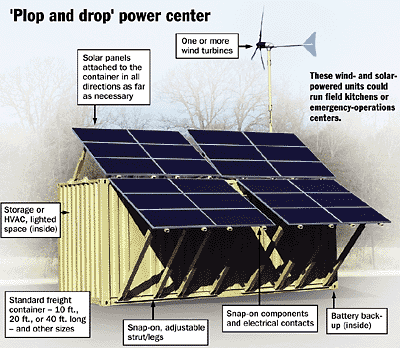SkyBuilt Power Inc. has begun
building electricity-generating units fueled mostly by solar and
wind energy. The units, which use a battery backup system when
the sun is down and the wind is calm, are designed to run for
years with little maintenance.Depending upon its
configuration, SkyBuilt's Mobile Power Station (MPS) can
generate up to 150 kilowatts of electricity, says David Muchow,
the firm's president and CEO. That's enough to power an
emergency operations center, an Army field kitchen, or a small
medical facility.
Privately owned SkyBuilt now has a new investor - In-Q-Tel, a
venture capital firm set up by the US Central Intelligence
Agency. Skybuilt and In-Q-Tel will announce Tuesday that they
have signed a strategic development agreement, including an
investment in SkyBuilt.
In-Q-Tel's support is a breakthrough for the small firm. (The
"Q" in In-Q-Tel is a whimsical play on the movie character "Q"
who supplies James Bond with nifty gadgets.) SkyBuilt provides
innovative energy solutions with the potential to help meet a
wide variety of critical government and commercial power needs,
says Gilman Louie, In-Q-Tel president and CEO.
The power stations could have important uses for disaster
relief, homeland security, military operations, intelligence
work, and a variety of commercial applications. The units are
not yet designed for use by homeowners.
Though it is not mentioned, SkyBuilt units would have obvious
applications in places like Afghanistan and Iraq, where soldiers
risk their lives over long supply lines to truck in fuel for
generators.
After hurricane Katrina, SkyBuilt units could have been
rushed to the scene and set up in hours, restoring power to
hospitals, evacuee centers, police and fire departments, and
cellphone towers.
One big drawback of solar energy until now has been that it
was a "custom industry," says Scott Sklar, vice president of
SkyBuilt. Components are usually put together on-site, and
differ from location to location. "When you buy a car, do they
ship in all the pieces to your front yard and have somebody
assemble it? I'm afraid not. We [at SkyBuilt] learned something
from Henry Ford," he adds.
SkyBuilt follows the Ford model. Its MPS units are what Sklar
calls "plop and drop, plug and play."
It works this way: Parts for each Skybuilt unit are packed
into standard-size shipping containers. The containers,
specially modified and strengthened, can be moved by ship,
truck, train, or even dropped by a laser-guided parachute to the
most remote location.
Once on-site, the container is opened, and arms and poles are
attached to the outside to hold solar cells and wind turbines. A
prototype built here in Arlington has been running steadily for
more than a year without repairs or maintenance.
While SkyBuilt has 140 patent claims on its energy system,
most of its individual component parts are widely available. Mr.
Muchow explains that its MPS can use photovoltaic cells, small
wind turbines, computers, batteries, and other parts from
essentially any manufacturer.
This open architecture allows its MPS units to be upgraded
whenever a battery or other manufacturer comes out with a better
product. It also reduces costs.
This was attractive to In-Q-Tel. The government could develop
its own advanced technology (as "Q" might do). But it is far
less costly to support technology like SkyBuilt's that also
finds a larger market in the private sector, says Troy Pearsall,
vice president of technology at In-Q-Tel.
In-Q-Tel, meanwhile, has signed agreements similar to this
one with more than 80 companies since it was set up in 1999. Its
mission is to identify and invest in firms with cutting-edge
technologies that can aid US national security.
